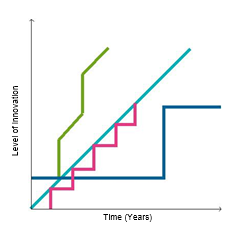by | Nadia Sullivan
Innovation is often associated with technological advances, new inventions, and/ or new ideas. Actually innovation is broader than that. It is the ability to apply new ideas to products, processes, organizational practices and business models. Innovation is a tool that can transform the way organization do business and enable the business to respond proactively to problems and/or opportunities presented by an increasingly globalized, knowledge-intensive marketplace. Innovation has become the new driver for productivity in the 21st century.
There are four types of Innovation
- Strategic Innovation – Quantum leaps of innovation and occur less frequently
- Tactical Innovation – Variations on existing theme and occur less frequently
- Cumulative Innovation – High performance and occur most frequently
- Operational Innovation – Small improvements to existing operations and made on day to day basis
Organizations that have achieved strategic innovation must also apply tactical innovations to introduce variations into the invention, whilst operational innovation helps to optimize their systems to maintain their market advantage for a long term. Regardless to the nature of business, an organization must innovate tactically and operationally to ensure sustainability, profitability and to stay relevant and updated.

Adapted from MacKenzie, L. (2004), Surviving in the Corporate Jungle: Strategies for becoming an innovative organization. In Innovation and Imagination at Work. McGraw Hill. Sydney.
Innovation in the public sector
Does public sector need innovation? Obviously it does, as enhancing public sector performance is a key goal of governments around the world. Innovation in the public sector, particularly in policy development, program design and service delivery is necessary for it to able to dispense better public services, more sensitive and responsive to community needs, and more efficient. Innovation is a forward-looking strategy, including some over the horizon thinking.
Public sector leaders often speak on the importance of innovation that needs to be fostered, recognized and rewarded throughout the organizations, ‘top-down’ and ‘bottom-up’. Many agencies and departments perceived innovation as a value or behavior to be encouraged.
It is important that leaders ‘walk the talk’. Innovation must be embedded in the corporate strategy to ensure better performance and to project productivity. Public sector whose leaders are consistent and persistent in disseminating the innovation culture into the organization and are willing to provide staff adequate training and development opportunities are more likely to be successful than those that do not.
For innovation to be successful there must be structured processes and resources to examine, try, support and conduct new ideas. Without such efficient and effective processes, inspirational and forward-looking ideas would not be transformed into new policies, services or methods of operation.
Public sector innovation would hardly be translated into outcomes without effective foresight and implementation. Influential and talented individuals are needed to identify those ideas. These individuals are the leaders with ‘Meta Skills’, the requirement for effective leadership in the 21st century.
21st Century ‘Meta Skills’ for Leaders:
- Engagement: Being able to motivate people through a sense of purpose, connection and commitment.
- Utilization: Knowing how to ‘mine’ the vast store of under-utilized knowledge, experience, and wisdom languishing at every workplace.
- Agility: Being able to adapt or respond quickly in transitional times.
- Creativity: Flexibility of thought that seeks new and/or original ways of thinking to solve complex problems. Creative thinking has become the core of leadership competency.
- Thinking strategically: See the big picture, be future focused and examine the situation from different points of view. Think global but act local.
- Democratization: Share ideas, influence and decision making. ‘Leading from the top’ vs ‘leading from the middle’.
- Entrepreneurialism: See opportunities and add value
Drivers for Innovation
Innovation is driven by motivated and cultivated variety of short, medium and long term factors. In any public service, the driving factor for innovation is the ability to respond effectively and efficiently to the new changing government and society expectation in a gradually complicated environment. Examples include the impact of ageing population; addressing stubborn social problems such as drug abuse and vulnerable community; supporting communities in rural and remote place; national security and counter‑terrorism; increasing concerns about climate change; the appropriate regulation of global financial markets and sustainable, effective and fair international development assistance.
To understand the issue in a more comprehensive way, one has to look at the innovation in health policy and how it responds to long term factors such as ageing population, socio- economic status, fast growing cost of new technologies, and other identifiable issues such as health awareness and lifestyle. Innovation in health care may be driven by government’s engagement in response to community concerns, medical research and technology improvements or local responses to local issues.
Innovation Framework
According to innovation edge, Australia, there are three drivers of innovation that organization can adopt and implement.
- Mindset – Learning the tools for idea generation, exploration and evaluation and how to apply them.
- Climate – Creating an organizational culture in which innovation can flourish.
- Channels – Establishing the routes and information channels through which innovation can flow.
Creating the mindset of innovation
Thomas Edison said it over a century ago, “Genius is one percent inspiration, 99 percent perspiration”. Innovation begins with someone being prepared to think a little differently. On the other hand, people who live in mental ruts block innovation and ruin innovative ideas. Innovative companies encourage innovation by creating the right climate for employees to cultivate the innovative mindset to think different, act different, and achieve extraordinary success.
Creating the climate for innovation
Creating a climate for innovation is about consistently welcoming and considering innovative ideas as a natural part of the working life. Such environment encourages creativity and influences productivity within the organization. It establishes an environment of trust where everyone feels empowered to contribute to the wellbeing and sustainability of the organization.

Creating the climate for innovation
Creating a climate for innovation is about consistently welcoming and considering innovative ideas as a natural part of the working life. Such environment encourages creativity and influences productivity within the organization. It establishes an environment of trust where everyone feels empowered to contribute to the wellbeing and sustainability of the organization.
Creating the channels for innovation
The best way of opening the channels and platforms for innovation is to encourage open communication, collaboration and knowledge sharing with colleagues, clients, competitors and the community.










